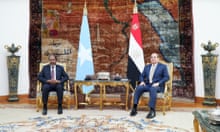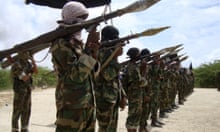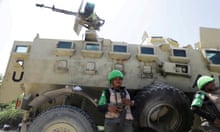Ciraa Farah Ali was asleep when she heard the flood. It was dark, and the 45-year-old mother of seven was alone with her children in her small home in Beledweyne, central Somalia.
She knew the level of the Shabelle River was rising but had little fear that it would burst its banks. Late in October, swollen by unseasonal rains, it did. Ali had no time to gather her belongings and only just managed to escape with her family.
“I could not save a single item from my house. The neighbours came to rescue my children when our house was submerged. My youngest girl was washed away but thanks be to God she was rescued later,” she said.
Not everyone was as lucky.
Nuriya Hassan Ma’ow lost her grandmother, Ruqiya, 75, and her son Mohamud, 11, as the family attempted to flee from the rising flood water in Beledweyne, 200 miles from the capital, Mogadishu. Both were drowned.
“I was not at home. Everybody ran away. We are in disaster and mourning. I don’t know what to do. God will help us,” said Ma’ow, a 37-year-old shop owner. “I have not a house. There is no government assisting us.”
Ma’ow is in a makeshift camp for the displaced in in Ceel Jaale. About 370,000 people have been displaced so far due to flooding, according to the latest UN figures.
Authorities have not yet said how many people died in the flooding, Somalia’s worst in recent history.

Beledweyne was worst hit. Its main hospital was shut after the main wards were inundated. With farmland and roads damaged or destroyed, communities already brought to the brink of disaster by drought and conflict are now threatened by malnutrition and disease.
“This is a catastrophic situation,” said the mayor, Safiyo Sheikh Ali. The Somali president, Mohamed Abdullahi Mohamed, who visited the town and waded through submerged areas, called the devastation “beyond our capacity” and pleaded for more help from aid groups.
Parts of the Lower Juba, Gedo and Bay regions have also been affected. Many displaced people were stranded without food, latrines or shelter.
The Somalia NGO Consortium, a coalition of more than 80 humanitarian NGOs, has said the country faces disaster, with as many as 6.3 million people without sufficient supplies of basic foodstuffs.
“The crises occurring within Somalia’s borders are a global responsibility. Climatic shocks are not a local phenomenon but a manifestation of the growing environmental emergency,” said Nasra Ismail, the consortium director.
Efforts attempting to provide food aid have been slowed by continuing rains which shut the airport in Beledweyne to relief flights.
Nur Ali Ebla, 39, said: “I was born in Beledweyne and this is the worst crisis I have ever witnessed. We don’t have shelter as the rains continue to drop on us.
“We have nothing. My husband is disabled and it was terrible when the floods came to our house becase I had to save my children and my husband at once.
“I did not have time to collect our belongings. So now we don’t even have the basics for cooking or preparing food. The flood took everything.”
Abdi Adan Isack, 37, was forced to flee the camp that he has been living in for the past five years to a new one on the outskirts of the city. His home has been destroyed.
“This is a new hardship coming to us. There is no place to return. My house was destroyed by the floods. We don’t have healthcare. My five-year-old son was sick for two days and now he is becoming weak,” Abdi said. “If we don’t get assistance of food and healthcare, this will turn into a famine.”
Habiba Muhumed Ali, 80, who is blind, was rescued last week by a group of volunteers who evacuated 137 survivors by boat from Beledweyne. Seven bodies were also recovered from the water, the Somali Red Crescent Society said.
“I could not see. I thought that I was going to die. Thanks God the boys [volunteers] rescued me,” Habiba said as she sat outside a makeshift house in Ceel Jaale camp. “We need food. We need drinking water. Everything is collapsed. I am scared to return.”
Abdi Abdullahi, who leads Red Crescent operations in Beledweyne, said rescues were continuing with boats and tractors but thousands of people were living in the open.
“Our concern is that another fatal disaster is on its way. We fear the floods could trigger deadly outbreaks of malaria, diarrhoea and other infectious diseases,” Abdullahi said.









